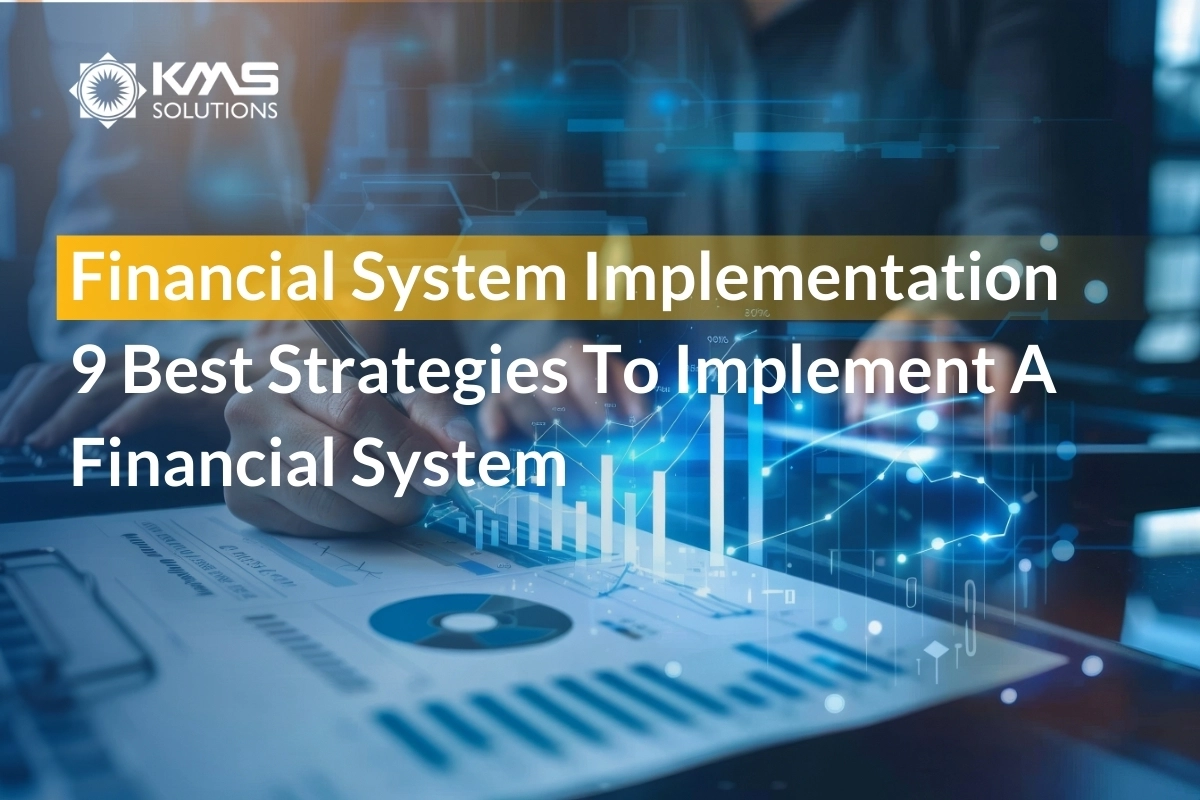Implementing a banking & financial system can be one of the most impactful decisions you make for your organization, but it’s not without its challenges. What if you could navigate these challenges with a clear roadmap that guarantees success?
In this article, we’ll dive into the 9 best strategies for implementing financial software that goes beyond basic functionality. Each one is designed to help you leverage your financial system as a strategic asset. By the end, you’ll fully understand what it takes to successfully implement a financial system!
1. What Is Financial System Implementation?

Implementing a financial system involves deploying and integrating financial software or platforms within an organization.
This process begins with identifying the organization’s specific needs and selecting a system that meets those requirements. Once a system is chosen, the implementation involves configuring the software to align with the organization’s financial processes, migrating data from existing systems, and ensuring seamless integration with other business applications.
2. Benefits of Banking & Financial System Implementation

Implementing a financial system might seem like a big task, but the benefits it brings to the table make it well worth the effort.
2.1 Improved Data Accuracy and Integrity
One key advantage of using a financial system is the marked enhancement in the precision of financial data. In traditional, manual financial processes, data entry is often prone to errors due to human oversight or misinterpretation. These errors can lead to inaccurate financial records, which can misinform management decisions and distort an organization’s financial health.
Financial system implementation streamlines data entry by minimizing mistakes and ensuring uniform and accurate data capture. These systems enforce standardization across financial records. Additionally, implementing a financial system significantly enhances data integrity by centralizing data management, automating processes, and enforcing strict access controls.
2.2 Scalability and Adaptability
Financial software can seamlessly scale to meet an organization’s growth, handling higher transaction volumes, more users, and new financial functions. Implementing scalable financial software helps you avoid expensive and time-consuming system upgrades, ensuring that your financial operations stay agile and responsive to market changes.
2.3 Better Compliance and Risk Management
In today’s complex regulatory environment, maintaining compliance with financial regulations is both challenging and essential for avoiding legal penalties and maintaining the organization’s reputation. A robust financial system is designed to help organizations stay compliant with a wide range of regulatory requirements, such as PCI DSS, GDPR, PSD2, etc..
3. Best Strategies To Implement A Financial System
When it comes to implementing a financial system, success is all about strategy. Although there’s no one-size-fits-all strategy for implementing a financial system, here are approaches that make the difference between a smooth transition that enhances your financial software and a rocky rollout that leads to confusion and frustration.
3.1 Define Your Requirements

To start implementing financial system, establishing clear and well-defined objectives and requirements is essential. These goals should align closely with the organization’s strategic ambitions and operational needs.
Setting specific, measurable targets provides a clear roadmap for the implementation process, ensuring that all stakeholders have a unified understanding of the desired results. When objectives are clearly defined, the implementation team can work together effectively to achieve them.
3.2 Assign a Business Lead

Next, a good business lead acts as the bridge between the technical team and the business users. He or she should have a deep understanding of the company’s financial processes and be able to translate business needs into technical requirements.
The business lead is responsible for making key decisions throughout the implementation process, such as prioritizing features, approving design changes, and ensuring that the project stays on track. They also play a critical role in stakeholder communication, keeping everyone informed about the project’s progress and any potential risks.
3.3 Build a Competent Implementation Team

For a successful software implementation, assembling a diverse team is key. This team usually comprises professionals with diverse skills, including project managers, software developers, subject matter experts, and end-users, each playing a vital role in facilitating a smooth transition. A strong implementation team combines technical expertise with a deep understanding of the organization’s goals, enabling them to translate these objectives into practical actions.
In the financial services sector, having team members with domain-specific expertise is important to navigate industry standards and regulatory requirements effectively. This blend of technical skills and financial knowledge ensures that the implementation is both efficient and compliant with necessary regulations.
3.4 Build Data Migration and Integration

During the implementation, the data migration process is also essential. However, migrating data from existing systems to the new financial software can be complex and challenging.
A robust data migration strategy involves data mapping, cleansing, and validation. Start by identifying the data that needs to be migrated, such as customer records, financial transactions, and vendor information. Next, develop a detailed data migration plan that outlines the steps for extracting, transforming, and loading (ETL) the data into the new system.
Integration with other systems, such as ERP or CRM platforms, is equally important. Additionally, it is essential for the new financial software to integrate effortlessly with the current system to guarantee smooth data transfer between all systems.
3.5 User Acceptance Testing (UAT)

User Acceptance Testing (UAT) is the process of verifying that the new financial system meets the business requirements and works as expected in real-world scenarios. UAT must include actual end-users who will interact with the system regularly. These users will test the system’s functionality, usability, and performance.
During UAT, create real-life scenarios that mimic the day-to-day operations of your finance team. For example, you might test the system’s ability to process invoices, generate financial reports, or manage payroll. All problems discovered during UAT must be recorded and addressed prior to the system’s launch.
3.6 Setup Project Documentation

Documentation serves multiple purposes. It provides a clear roadmap for the implementation process, ensures that everyone involved is on the same page, and acts as a reference guide for future system maintenance or upgrades.
Thorough documentation will involve all of these aspects:
- Risks Log: A list where you track all possible risks, their impact, how likely they are to happen, and your plans to deal with them.
- Action Log: A list that keeps track of who is responsible for each task and when it should be done. Review this list in every team meeting to make sure everyone is on track.
- Issues Log: A list of problems that come up unexpectedly and need to be fixed.
- Decision Log: A list of all the important decisions made during the project.
3.7 Choosing the Right Financial System Implementation Vendor

When choosing a vendor for financial system implementation, ensure they have the technical expertise to manage your specific software, including understanding system integration, data migration, and customization. Their tech stack should be compatible with your existing systems to ensure smooth operation. Additionally, the vendor must stay current with the latest technologies and trends to keep your systems up-to-date and adaptable.
Domain knowledge in the BFSI industry is another consideration, as is their ability to comply with financial regulations and standards like GDPR and PCI DSS. This confirms that the vendor can address industry-specific needs and maintain regulatory compliance, safeguarding your institution’s data and operations.
3.8 Maintain Open Communication Channels
Regular and transparent communication helps in addressing concerns promptly, clarifying objectives, and aligning expectations among team members, management, and external partners. Effective communication also facilitates quick identification and resolution of any issues or challenges that may arise during implementation. By encouraging feedback and fostering collaborative discussions, organizations can adapt strategies as needed.
3.9 Provide Training and Support

Ongoing support is equally important. It confirms that employees understand how to use the system effectively, reducing the risk of errors and enhancing overall productivity. Tailored training programs should be designed to meet the specific needs of different user groups, from end-users to IT staff, ensuring everyone is well-equipped to utilize the system’s features fully.
4. Challenges in Financial System Implementation and How To Overcome?

When implementing financial software, challenges can range from technical issues to human factors, and if not addressed properly, they can lead to significant delays, increased costs, or even failure of the project.
#1: User Resistance and Training
Users may resist the adoption of a new financial system due to fear of change, lack of understanding, or concerns about job security. Resistance can slow down implementation and lead to underutilization of the system’s capabilities.
Tips to solve:
- Implement a structured change management process that includes clear communication about the benefits of the new system, timelines, and how it will impact users’ daily tasks.
- Involve key stakeholders in the implementation process to ensure that their needs are met and to build a sense of ownership and buy-in.
#2: Cost Overruns and Budget Constraints
Financial system implementation projects often experience cost overruns due to underestimation of required resources, scope creep, or unforeseen technical issues.
Tips to solve:
- Develop a realistic budget that includes a contingency fund for unexpected expenses. Use historical data from similar projects to guide estimates.
- Negotiate with vendors to secure better pricing or flexible payment terms that align with the project’s financial constraints.
#3: Data Migration
Migrating large volumes of financial data from old systems to a new one is fraught with risks. Data might be incomplete, incompatible, or corrupted during the transfer.
Tips to solve:
- Before migration, clean the data to remove duplicates, correct errors, and ensure consistency.
- Run the old and new systems in parallel for a defined period to compare outputs and ensure that the new system is processing data correctly.
5. Conclusion
In summary, successful financial system implementation requires careful planning and execution based on best practices. The nine strategies outlined will guide you through this complex process.
To stay ahead in an increasingly digital world, it’s essential to partner with a provider that offers cutting-edge technology and expertise. KMS Solutions is renowned for its expertise in implementing software tailored for the banking and financial services sector. Our offerings include:
- Greenfield Implementation: Assist organizations in successfully implementing new software systems by offering comprehensive guidance and support.
- Progressive Transformation: Revamp your bank’s support systems and back-office technologies to align with customer expectations and maintain a competitive edge.
- Cloud Native Platform for Innovation: Utilize the Cloud Delivery Model, cutting-edge technologies, and the expertise of KMS talents to accelerate innovation.
Are you interested in any of our implementation services for the effective finance system? Contact our expert now!












